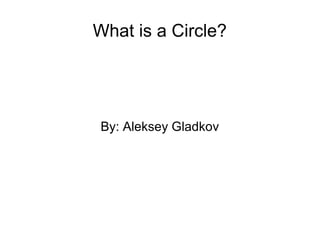What is a circle
•Download as PPT, PDF•
0 likes•237 views
A circle is a 2D projection of a 1D line that allows for additional dimensions. While often seen as illogical, circular reasoning can be valid if its circular nature is recognized and it doesn't continue indefinitely. Ultimately, circles represent a way to simplify and make binary distinctions about the universe from a framed perspective.
Report
Share
Report
Share

Recommended
Recommended
The mathematics the way algorithms think / the mathematics the way we think20130523 06 - The mathematics the way algorithms think / the mathematics the ...

20130523 06 - The mathematics the way algorithms think / the mathematics the ...LeClubQualiteLogicielle
More Related Content
Similar to What is a circle
The mathematics the way algorithms think / the mathematics the way we think20130523 06 - The mathematics the way algorithms think / the mathematics the ...

20130523 06 - The mathematics the way algorithms think / the mathematics the ...LeClubQualiteLogicielle
Similar to What is a circle (20)
20130523 06 - The mathematics the way algorithms think / the mathematics the ...

20130523 06 - The mathematics the way algorithms think / the mathematics the ...
Fuzzy mathematics:An application oriented introduction

Fuzzy mathematics:An application oriented introduction
The Relevance and Irrelevance of Heisenberg’s Uncertainty Principle for the Q...

The Relevance and Irrelevance of Heisenberg’s Uncertainty Principle for the Q...
What is a circle
- 1. What is a Circle? By: Aleksey Gladkov
- 2. Simple At First Glance Circles are actually figures of near infinite complexity, which can explain the very foundtions of our mathematical system.
- 3. Projection A circle is actually a 2 dimensional projection of a 1 dimensional object, a line. The nice thing is, you get 2 more dimensions for free.
- 4. 3 Dimensions In higher dimensions choice starts to become a factor. Do you project into 3d space as a sphere or a spiral? Both are valid circular 2d objects.
- 5. 4 Dimensions Further choice is added in time, as to how you decide to draw your 1,2, or 3 dimensional object. You start with a point, and it is all choice from there.
- 6. Rationality So called circular logic is often frouned upon as fallacious, but I see it as logic that can support itself, provided you can spot its circular nature and stop in the right time.
- 7. Number Theory We can now tackle the true crux of the matter, prime number theory. I postulate that there are only 2 real prime numbers, 0 and 1,since all other numbers can be expressed rationally by simple inversion as a fraction or as a more complex function of these two, and all mathematical systems are based in binary ideals, the idea that nothing and something are different, that the difference is real and measurable, and most of all significant.
- 8. The Look of Things We don't have to stop there though. We can use our understanding of dimensionality to further collapse the problem into a single solution. Both 0 and 1 can be the same object viewed at different times, from different sides, and thus mathematics resolves into a mirror of reality, a window back into our own world, just a little different due to temporary perspective shift (relativity), and counting higher than one (or trying to solve pi) becomes running around in a circle wondering why it takes so long to reach the end.
- 9. Circular Logic The most important thing about measuring circles is knowing when to stop. At this point the argument loops back around to the nature of circles, and we know it is time to stop having it. Thank You Very Much Best Regards projectLeX
- 10. So what is a circle? It is a way to binarize the universe with relativity by setting up a frame of reference.